Spatio-Temporal Changes in Land Use and Habitat Quality of Hobq Desert along the Yellow River Section
Abstract
:1. Introduction
2. Materials and Methods
2.1. Study Area
2.2. Data Sources and Data Processing
2.3. Research Methods
2.3.1. Land-Use Monitoring
- (1)
- Dynamic indicators of land use
- (2)
- Land-use transfer change
2.3.2. Description Index of Landscape Pattern
2.3.3. Assessment of Habitat Quality
2.3.4. Prediction Based on PLUS Model
2.3.5. Geographical Detector Method
3. Results
3.1. Analysis of Land-Use Change from 1991 to 2019
3.1.1. Land-Use Type Change
3.1.2. Land-Use Dynamic Change
3.1.3. Land-Use Transfer Matrix
3.2. Landscape Pattern
3.3. Habitat Quality
3.3.1. Temporal Changes in Habitat Quality
3.3.2. Spatial Variation in Habitat Quality
3.3.3. Factors Influencing the Spatial Variation in Habitat Quality
3.4. Prediction of Land Use and Habitat Quality (2030)
4. Discussion
4.1. Reasons for Land-Use Change
4.2. Impact of Land-Use Change on Habitat Quality
4.3. Limitations and Uncertainties
5. Conclusions
- (1)
- From 1991 to 2019, the transition of all land types was frequently in the region studied; numerous areas of sandy land were turned into forest grassland, and the percentage of cultivated land and construction land continued to increase, whereas the water area decreased continuously, and the unused land decreased first and improved later. Among them, the construction land grew fastest in 2000–2010; the unused land expanded sharply in 2010–2019, and the highest comprehensive land-use dynamics were in the final period, with the most dramatic degree of land-use change.
- (2)
- As a result of the landscape indices, land use landscape fragmentation has increased, landscape connectivity has become better, and the overall landscape type has developed in a balanced manner. In terms of plaque type, the landscapes with forest grassland dominance increased, the leading variety in sandy landscapes decreased, the patches of cultivated landscapes showed complex trends, and the distribution in construction and unused landscapes scattered with time.
- (3)
- Habitat quality in the Hobq Desert from 1991 to 2019 shows positive development, evidenced by the shift from regions with relatively low and low habitat quality ratings to those with relatively high and high habitat quality ratings. In terms of spatial distribution, the habitat quality has a certain regularity, and the overall pattern is high in the south, low in the north, high in the east and west, and low in the middle.
- (4)
- In terms of the prediction, land-use change in the study area from 2019 to 2030 will basically be the same as in the previous period, but the speed will generally decrease. The concentration of unused land in the northwest corner of the desert will increase significantly. Meanwhile, the variation in habitat quality intensity will fall, the areas with invariable-grade habitat quality will increase, and the spatial distribution pattern will change slightly.
Author Contributions
Funding
Institutional Review Board Statement
Informed Consent Statement
Data Availability Statement
Conflicts of Interest
References
- Sharma, R.; Nehren, U.; Rahman, S. Modeling land use and land cover changes and their effects on biodiversity in Central Kalimantan, Indonesia. Land 2018, 7, 57. [Google Scholar] [CrossRef] [Green Version]
- Falcucci, A.; Maiorano, L.; Boitani, L. Changes in land-use/land-cover patterns in Italy and their implications for biodiversity conservation. Landsc. Ecol. 2007, 22, 617–631. [Google Scholar] [CrossRef]
- Ellis, E.C. Anthropogenic transformation of the terrestrial biosphere. Philos. Trans. R. Soc. A 2011, 369, 1010–1035. [Google Scholar] [CrossRef] [PubMed]
- Wang, X.; Wu, J.; Liu, Y.; Hai, X. Driving factors of ecosystem services and their spatiotemporal change assessment based on land use types in the Loess Plateau. J. Environ. Manag. 2022, 311, 114835. [Google Scholar] [CrossRef] [PubMed]
- Zhu, L.; Meng, J.; Zhu, L. Applying Geodetector to disentangle the contributions of natural and anthropogenic factors to NDVI variations in the middle reaches of the Heihe River Basin. Ecol. Indic. 2022, 117, 106545. [Google Scholar] [CrossRef]
- Wu, X.; Wang, S.; Fu, B.; Liu, Y.; Zhu, Y. Land use optimization based on ecosystem service assessment: A case study in the Yanhe watershed. Land Use Policy 2018, 72, 303–312. [Google Scholar] [CrossRef]
- Jiang, P.; Cheng, L.; Li, M.; Zhao, R.; Huang, Q. Analysis of landscape fragmentation processes and driving forces in wetlands in arid areas: A case study of the middle reaches of the Heihe River, China. Ecol. Indic. 2014, 46, 240–252. [Google Scholar] [CrossRef]
- Zhang, X.; Song, W.; Lang, Y.; Feng, X.; Yuan, Q.; Wang, J. Land use changes in the coastal zone of China’s Hebei Province and the corresponding impacts on habitat quality. Land Use Policy 2020, 99, 104957. [Google Scholar] [CrossRef]
- Boumans, R.; Roman, J.; Altman, I.; Kaufman, L. The Multiscale Integrated Model of Ecosystem Services (MIMES): Simulating the interactions of coupled human and natural systems. Ecosyst. Serv. 2015, 12, 30–41. [Google Scholar] [CrossRef]
- Ulucak, R.; Erdogan, F.; Bostanci, S.H. A STIRPAT-based investigation on the role of economic growth, urbanization, and energyconsumption in shaping a sustainable environment in the Mediterranean region. Environ. Sci. Pollut. Res. 2021, 28, 55290–55301. [Google Scholar] [CrossRef]
- Shah, M.; Cummings, A.R. An analysis of the influence of the human presence on the distribution of provisioning ecosystem services: A Guyana case study. Ecol. Indic. 2021, 122, 107255. [Google Scholar] [CrossRef]
- Mengist, W.; Soromessa, T.; Feyisa, G.L. Landscape change effects on habitat quality in a forest biosphere reserve: Implications for the conservation of native habitats. J. Clean. Prod. 2021, 329, 129778. [Google Scholar] [CrossRef]
- Hamilton, S.; O’Dwyer, C.; Dettmann, P.; Curtis, A. The habitat quality of private land Box-Ironbark remnant vegetation in southern Australia. J. Sustain. Agric. 2004, 25, 19–42. [Google Scholar] [CrossRef]
- Tripathi, G.; Deora, R.; Singh, G. The influence of litter quality and micro-habitat on litter decomposition and soil properties in a silvopasture system. Elsevier Bimon. 2013, 50, 40–50. [Google Scholar] [CrossRef]
- Stone, M.; Whiles, M.; Webber, J.; Williard, K. Macroinvertebrate communities in agriculturally impacted southern Illinois streams: Patterns with riparian vegetation, water quality, and in-stream habitat quality. J. Environ. Qual. 2005, 34, 907–917. [Google Scholar] [CrossRef] [PubMed]
- Zlinszky, A.; Heilmeier, H.; Balzter, H.; Czucz, B.; Pfeifer, N. Remote Sensing and GIS for Habitat Quality Monitoring: New Approaches and Future Research. Remote Sens. 2015, 7, 7987–7994. [Google Scholar] [CrossRef] [Green Version]
- Yi, Y.; Zhang, C.; Zhu, J.; Zhang, Y.; Sun, H.; Kang, H. Spatio-Temporal Evolution, Prediction and Optimization of LUCC Based on CA-Markov and InVEST Models: A Case Study of Mentougou District, Beijing. Int. J. Environ. Res. Public Health 2022, 19, 2432. [Google Scholar] [CrossRef]
- Moreira, M.; Fonseca, C.; Vergilio, M.; Calado, H.; Gil, A. Spatial assessment assessment of habitat conservation status in a Macaronesian island based on the InVEST model: A case study of Pico Island (Azores, Portugal). Land Use Policy 2018, 78, 637–649. [Google Scholar] [CrossRef]
- Sherrouse, B.C.; Semmens, D.J.; Clement, J.M. An application of Social Values for Ecosystem Services (SolVES) to three national forests in Colorado and Wyoming. Ecol. Indic. 2014, 36, 68–79. [Google Scholar] [CrossRef]
- Lahiji, R.N.; Dinan, N.M.; Liaghati, H.; Ghaffarzadeh, H.; Vafaeinejad, A. Scenario-based estimation of catchment carbon storage: Linking multi-objective land allocation with InVEST model in a mixed agriculture-forest landscape. Front. Earth Sci. 2020, 14, 637–646. [Google Scholar] [CrossRef]
- Imran, M.; Din, N. Geospatially mapping carbon stock for mountainous forest classes using InVEST modeland Sentinel-2 data: A case of Bagrote valley in the Karakoramrange. Arab. J. Geosci. 2021, 14, 756–768. [Google Scholar] [CrossRef]
- Leh, M.D.K.; Matlock, M.D.; Cummings, E.C.; Nalley, L.L. Quantifying and mapping multiple ecosystem services change in West Africa. Agric. Ecosyst. Environ. 2013, 165, 6–18. [Google Scholar] [CrossRef]
- Terrado, M.; Sabater, S.; Chaplinkramer, B. Model development for the assessment of terrestrial and aquatic habitat quality in conservation planning. Sci. Total Environ. 2016, 540, 63–70. [Google Scholar] [CrossRef] [PubMed] [Green Version]
- Che, X.; Jiao, L.; Qin, H.; Wu, J. Impacts of Climate and Land Use/Cover Change on Water Yield Services in the Upper Yellow River Basin in Maqu County. Sustainability 2022, 14, 10363. [Google Scholar] [CrossRef]
- Dong, X.; Wang, X.; Wei, H.; Fu, B.; Wang, J.; Uriarte-Ruiz, M. Trade-offs between local farmers’ demand for ecosystem services and ecological restoration of the Loess Plateau, China. Ecosyst. Serv. 2021, 49, 101295. [Google Scholar] [CrossRef]
- Long, H.; Liu, Y.; Hou, X.; Li, T.; Li, Y. Effects of land use transitions due to rapid urbanization on ecosystem services: Implications for urban planning in the new developing area of China. Habitat Int. 2014, 44, 536–544. [Google Scholar] [CrossRef]
- Mamanis, G.; Vrahnakis, M.; Chouvardas, D.; Nasiakou, S.; Kleftoyanni, V. Land Use Demands for the CLUE-S Spatiotemporal Model in an Agroforestry Perspective. Land 2021, 10, 1097. [Google Scholar] [CrossRef]
- Chu, L.; Sun, T.; Wang, T.; Li, Z.; Cai, C. Evolution and prediction of landscape pattern and habitat quality based on CA-Markov and InVEST Model in Hubei Section of Three Gorges Reservoir Area (TGRA). Sustainability 2018, 10, 3854. [Google Scholar] [CrossRef] [Green Version]
- Li, X.; Liu, Z.; Li, S.; Li, Y. Multi-Scenario Simulation Analysis of Land Use Impacts on Habitat Quality in Tianjin Based on the PLUS Model Coupled with the InVEST Model. Sustainability 2022, 14, 6923. [Google Scholar] [CrossRef]
- Liang, X.; Guan, Q.F.; Clarke, K.C.; Liu, S.S.; Wang, B.Y.; Yao, Y. Understanding the drivers of sustainable land expansion using a patch-generating land use simulation (PLUS) model: A case study in Wuhan, China. Comput. Environ. Urban Syst. 2021, 85, 101569. [Google Scholar] [CrossRef]
- Zhong, S.; Han, Z.; Li, A.; Du, H. Research on the Application of Palm Mat Geotextiles for Sand Fixation in the Hobq Desert. Sustainability 2019, 11, 1751. [Google Scholar] [CrossRef] [Green Version]
- Mu, L.; Fang, L.; Dou, W.; Wang, C.; Qu, X.; Yu, Y. Urbanization-induced spatio-temporal variation of water resources utilization in northwestern China: A spatial panel model based approach. Ecol. Indic. 2021, 125, 107457. [Google Scholar] [CrossRef]
- Zhang, D.; Wang, J.; Wang, Y.; Xu, L.; Zheng, L.; Zhang, B.; Bi, Y.; Yang, H. Is There a Spatial Relationship between Urban Landscape Pattern and Habitat Quality? Implication for Landscape Planning of the Yellow River Basin. Int. J. Environ. Res. Public Health 2022, 19, 11974. [Google Scholar] [CrossRef] [PubMed]
- Fang, Z.; Ding, T.; Chen, J.; Xue, S.; Zhou, Q.; Wang, Y. Impacts of land use/land cover changes on ecosystem services in ecologically fragile regions. Total Environ. 2022, 831, 154967. [Google Scholar] [CrossRef] [PubMed]
- Hangjin Banner People’s Government. Available online: http://www.hjq.gov.cn/sj_94857/tjgb/202004/t20200416_2607322.html (accessed on 30 October 2022).
- Geospatial Data Cloud. Remote Sensing Images. Available online: https://www.gscloud.cn/ (accessed on 11 October 2020).
- Chinese Academy of Sciences. National Earth System Science Data Sharing Infrastructure. Available online: http://www.geodata.cn/ (accessed on 30 October 2022).
- Chinese Academy of Sciences. Available online: https://www.resdc.cn (accessed on 30 October 2022).
- Global Geographic Information Resources Directory Service. Available online: https://www.webmap.cn/ (accessed on 28 October 2022).
- Hemmavanh, C.; Ye, Y.; Yoshida, A. Forest land use change at Trans-Boundary Laos-China Biodiversity Conservation Area. J. Geogr. Sci. 2010, 20, 889–898. [Google Scholar] [CrossRef]
- Zheng, X.; Zhao, L.; Xiang, W.; Li, N.; Lv, L.; Yang, X. A coupled model for simulating spatio-temporal dynamics of land-use change: A case study in Changqing, Jinan, China. Landsc. Urban Plan. 2012, 106, 51–61. [Google Scholar] [CrossRef]
- Li, H.B.; Wu, J.G. Use and misuse of landscape indices. Landsc. Ecol. 2004, 19, 389–399. [Google Scholar] [CrossRef] [Green Version]
- Lin, Y.; Lin, W.; Wang, Y.; Lien, W.; Huang, T.; Hsu, C.; Schmeller, D.S.; Crossman, N.D. Systematically designating conservation areas for protecting habitat quality and multiple ecosystem services. Environ. Model. Softw. 2017, 90, 126–146. [Google Scholar] [CrossRef]
- Zhang, X.; Zhou, J.; Li, M. Analysis on spatial and temporal changes of regional habitat quality based on the spatial pattern reconstruction of land use. Acta Geogr. Sin. 2020, 75, 160–178. [Google Scholar]
- Zhang, D.C.; Liu, X.P.; Yao, Y.; Zhang, J.B. Simulating Spatiotemporal Change of Multiple Land Use Types in Dongguan by Using Random Forest Based on Cellular Automata. Geogr. Geo-Inf. Sci. 2016, 32, 29–36. [Google Scholar]
- Wang, J.; Li, X.; Christakos, G.; Liao, Y.; Zhang, T.; Gu, X.; Zheng, X. Geographical detectors-based health risk assessment and its application in the neural tube defects study of the Heshun Region, China. Int. J. Geogr. Inf. Sci. 2010, 24, 107–127. [Google Scholar] [CrossRef]
- Wu, X.; Gao, Y.; Dang, X.; Zhang, C.; Du, B.; Zhang, H.; Bao, X. Spatial and temporal variation of vegetation cover in the Kubuqi Desert from 1989–2019. Bull. Soil Water Conserv. 2022, 42, 300–306. [Google Scholar]
- He, L.; Liang, H.; Li, G.; Liu, X.; Qi, R. Analysis on the Characteristics of Changes and Driving Forces of Vegetation Cover in Hangjin County in Recent 20 years. J. Ecol. Rural 2021, 37, 587–596. [Google Scholar]
- Zhang, X.; Jin, H.; Liu, b. Environment changes in the Hobq Desert since the Last Glacial Maximum. J. For. Res. 2021, 41, 81–93. [Google Scholar]
- Zheng, Y.; Qi, Y.; Quan, Y. Fifty-year Climate Change Characteristics in Kubuqi Desert and Surrounding Area. J. In. Mon. Sci. Technol. 2019, 45, 47–49. [Google Scholar]
- Zhao, M.; Zhou, L.; Wang, S. Effect of Ecological Policies on Land Use Types and Ecosystem Service Values in Hobq Desert. Res. Soil Water Conserv. 2017, 24, 252–258. [Google Scholar]
- Echeverría, C.; Newton, A.; Nahuelhual, L.; Coomes, D.; Rey-Benayas, J.M. How landscapes change: Integration of spatial patterns and human processes in temperate landscapes of southern Chile. Appl. Geogr. 2012, 32, 822–831. [Google Scholar] [CrossRef]
- Yan, D.; Yan, T. Overview of development for mobile sand control technology in Inner Mongolia, China. J. For. Res. 2022, 42, 66–70. [Google Scholar]
- Tang, F.; Fu, M.; Wang, L.; Zhang, P. Land-use change in Changli County, China: Predicting its spatio-temporal evolution in habitat quality. Ecol. Indic. 2020, 117, 106719. [Google Scholar] [CrossRef]
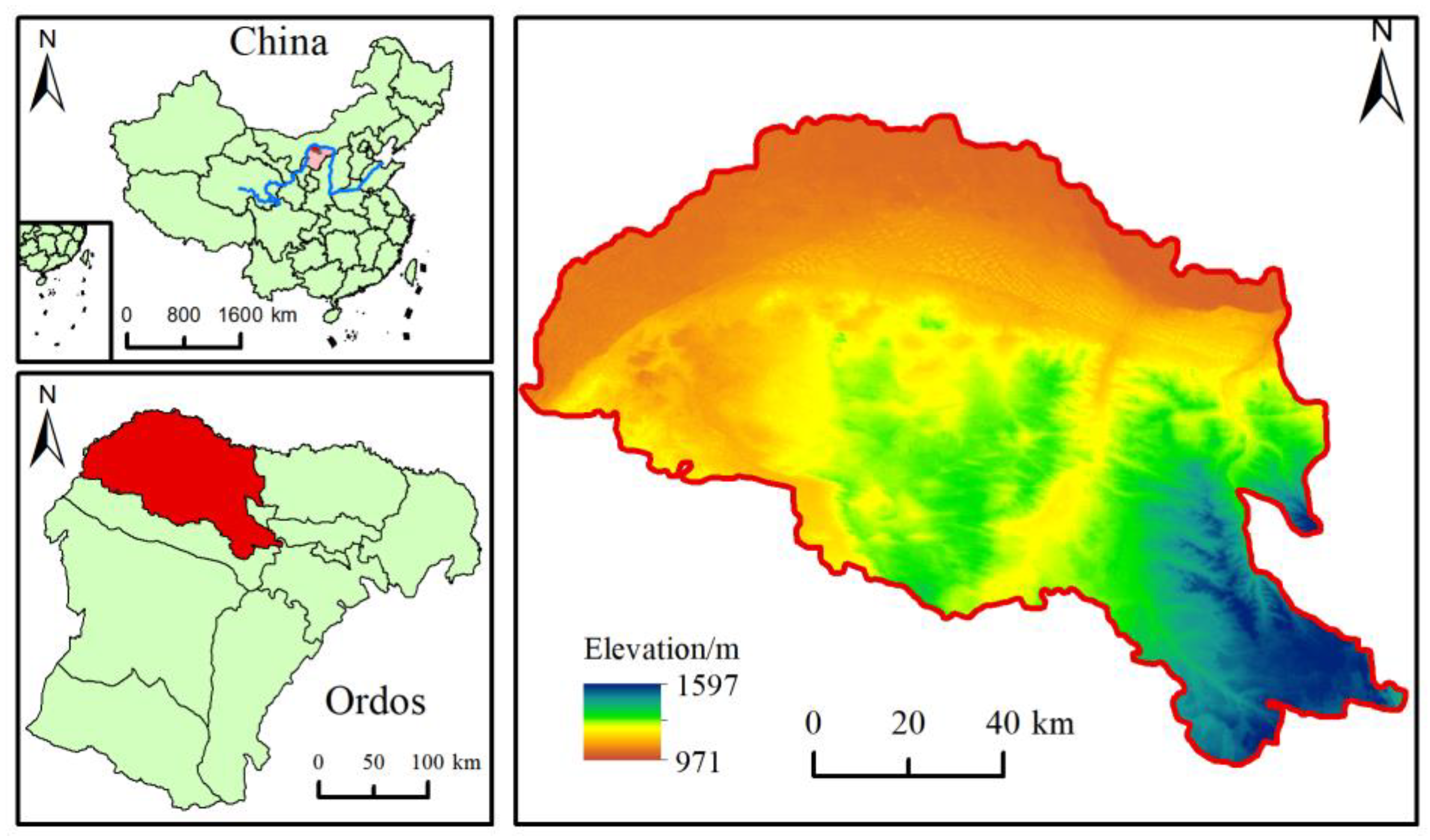
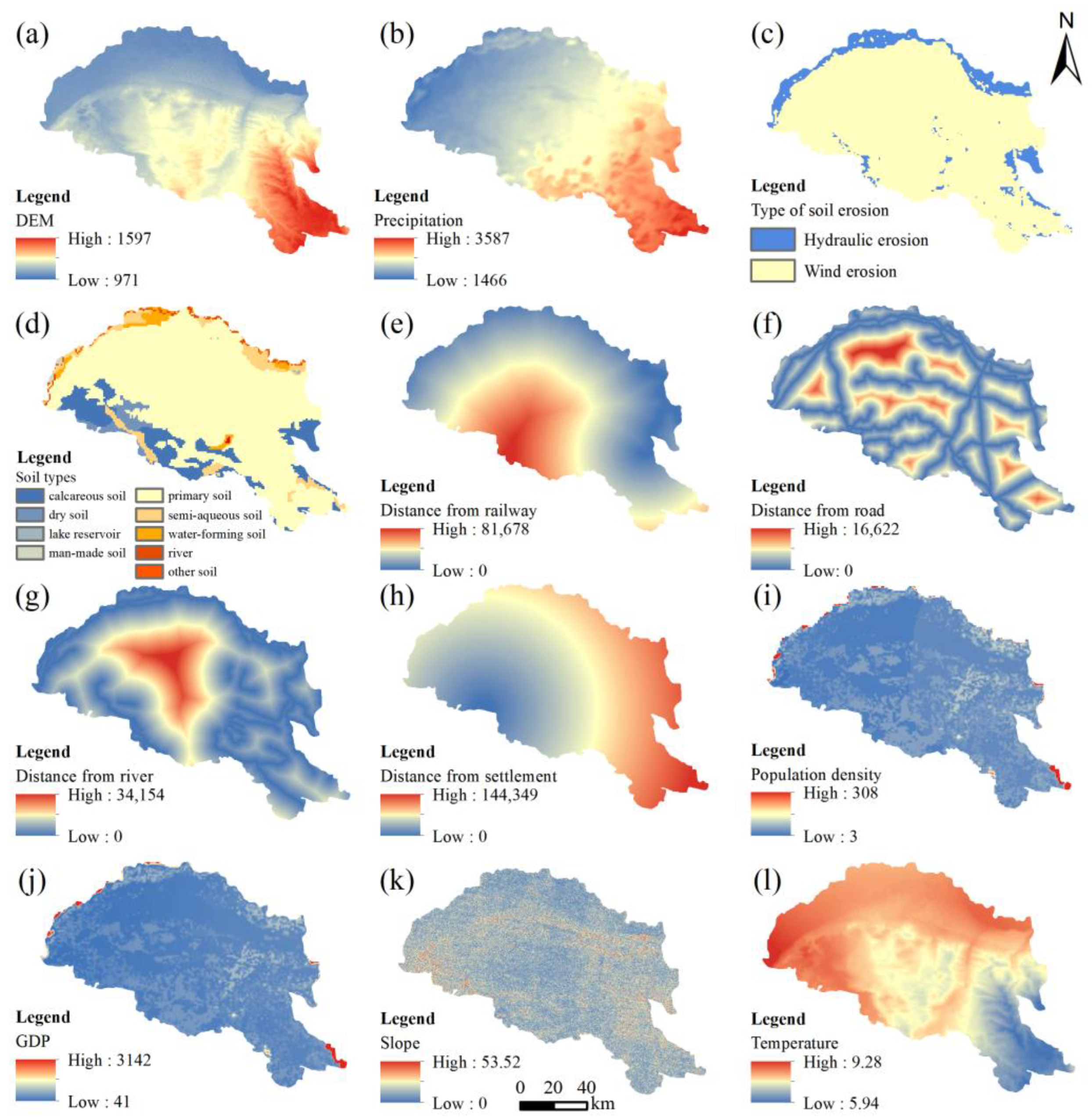


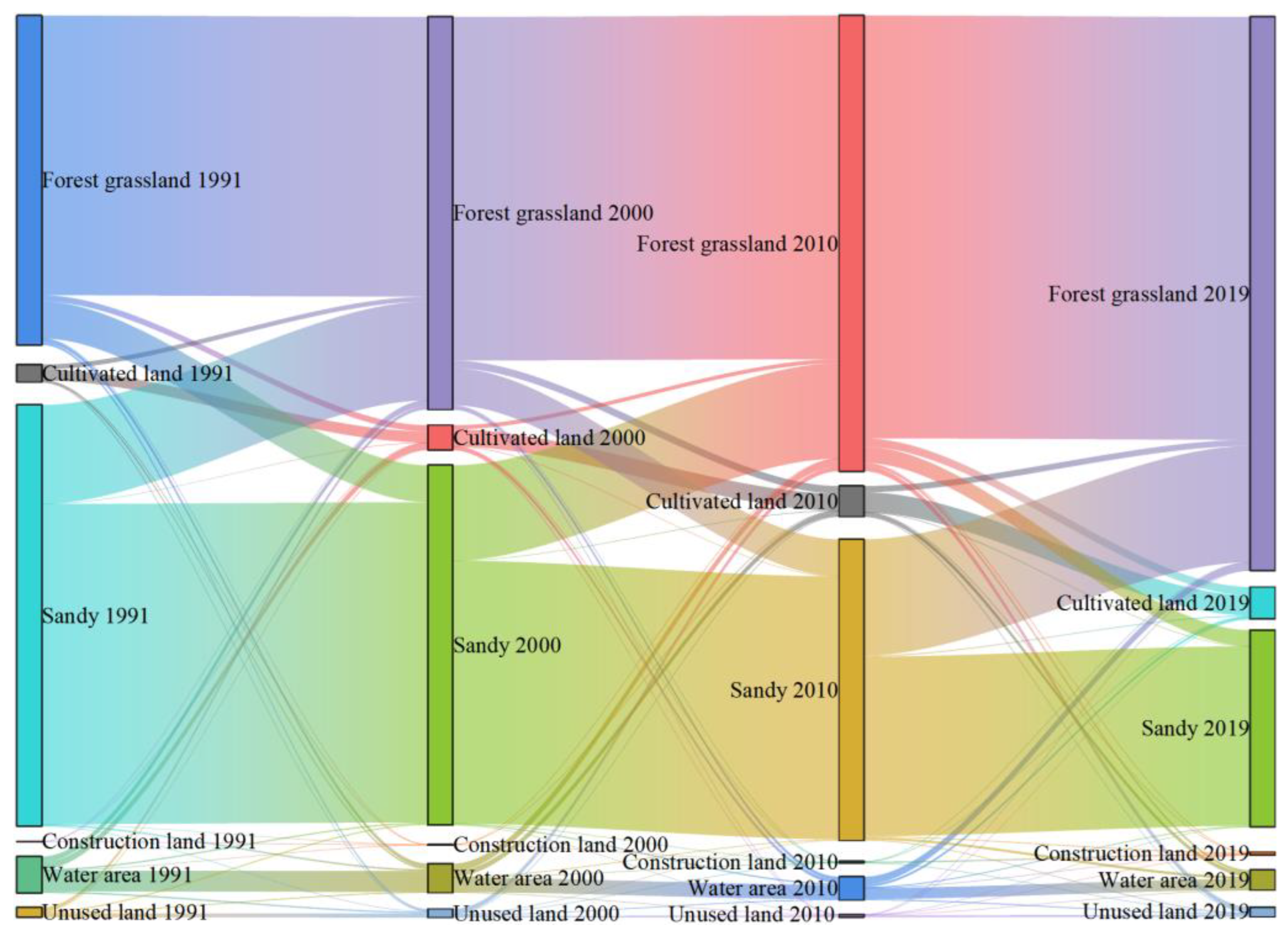
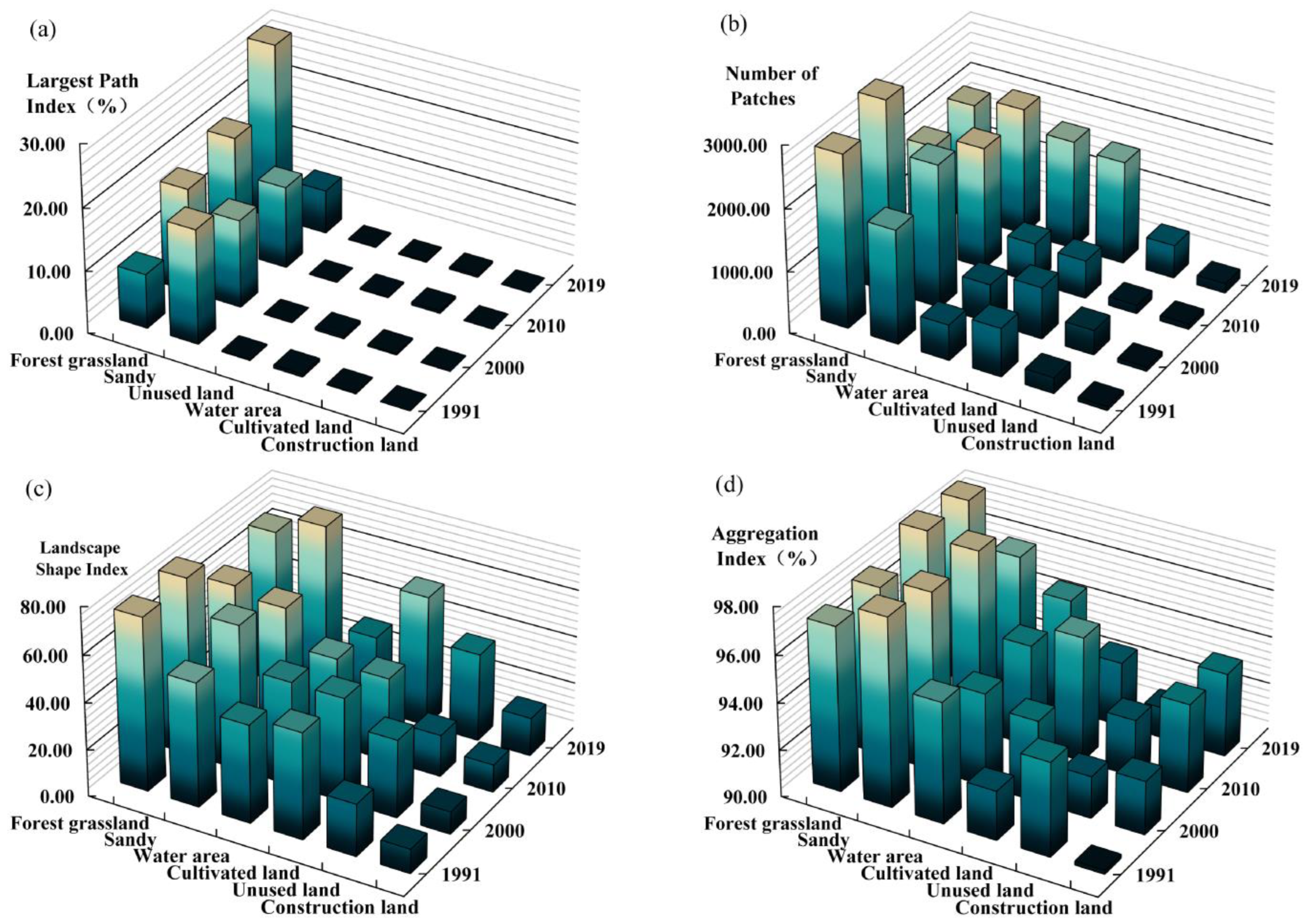
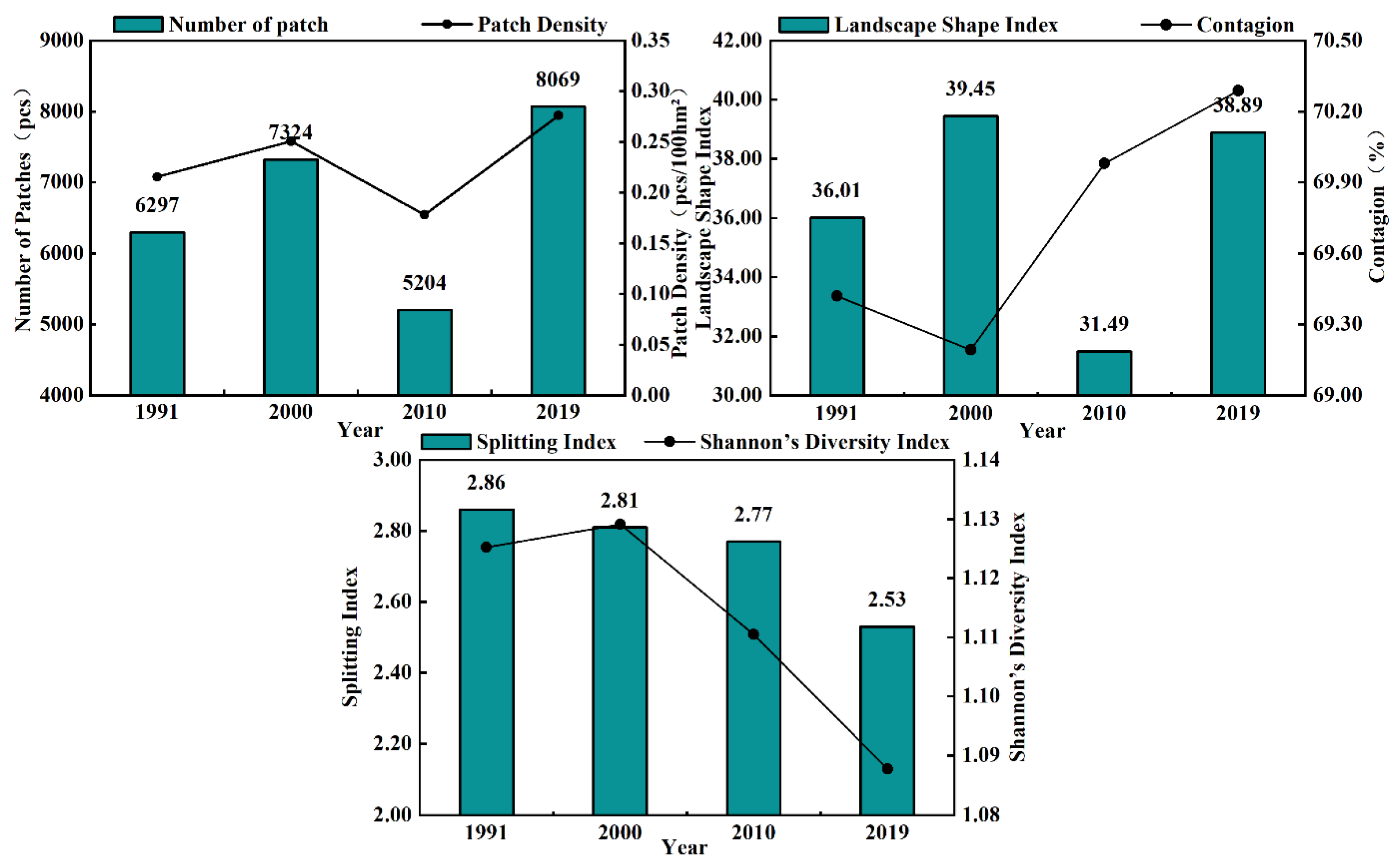
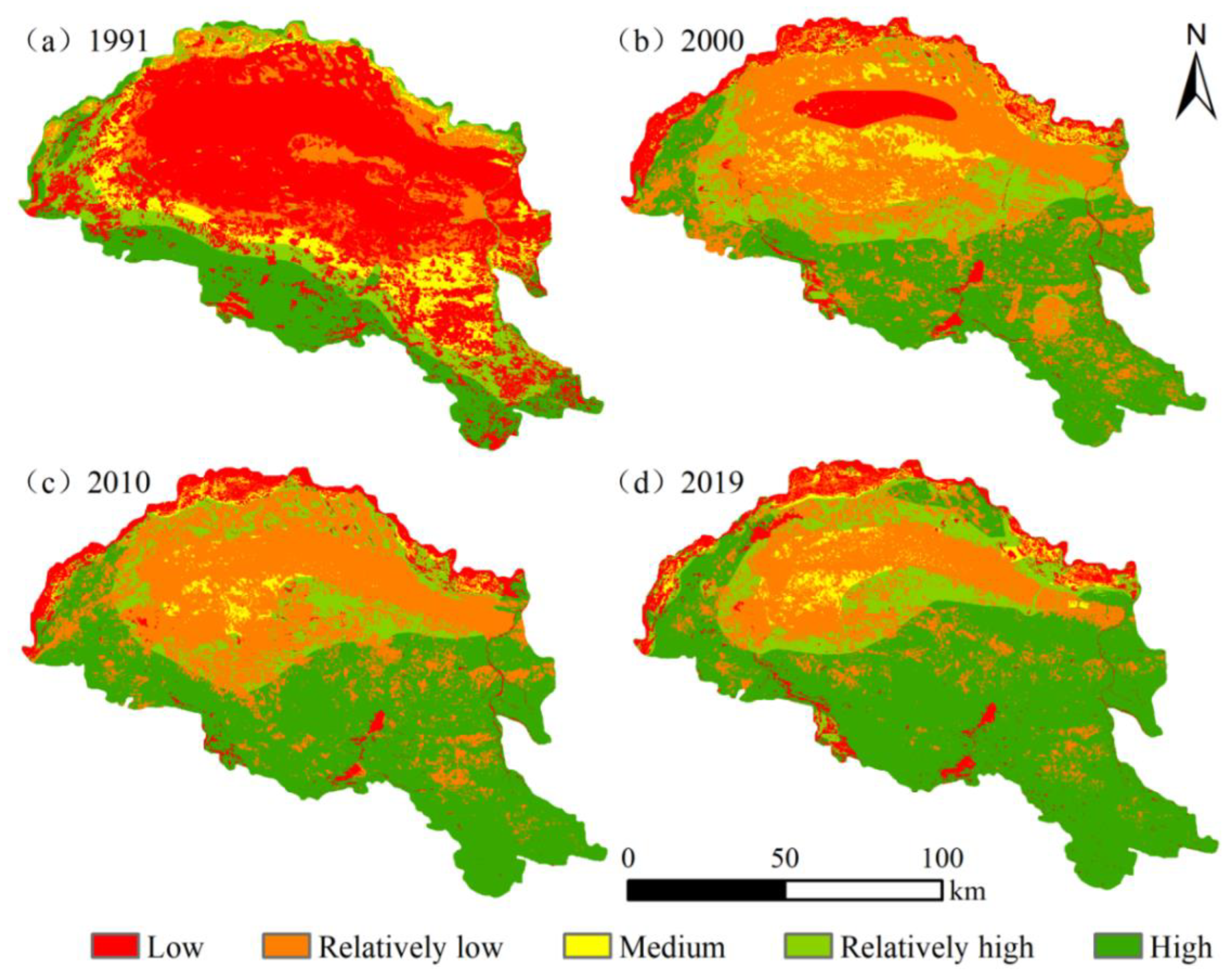
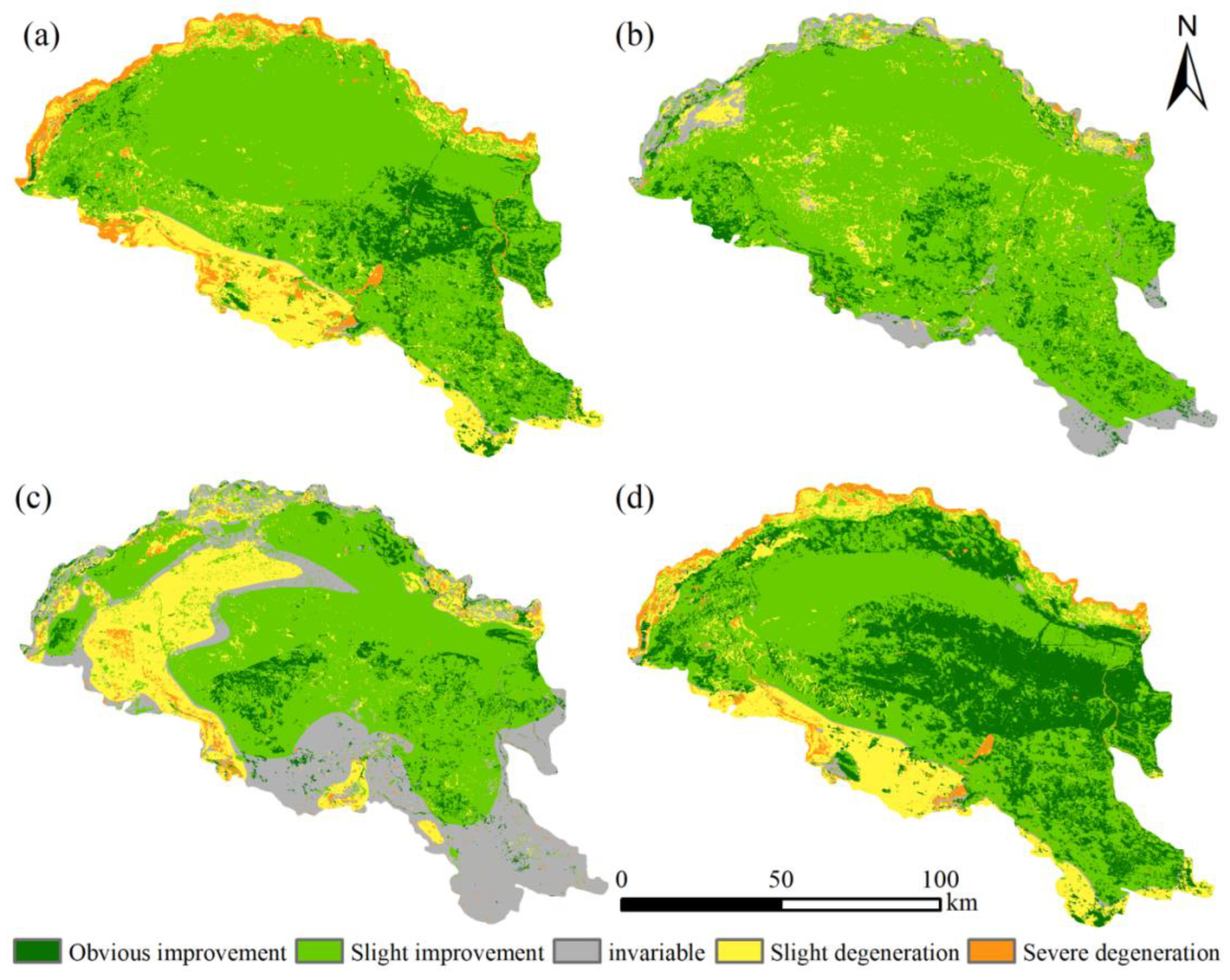
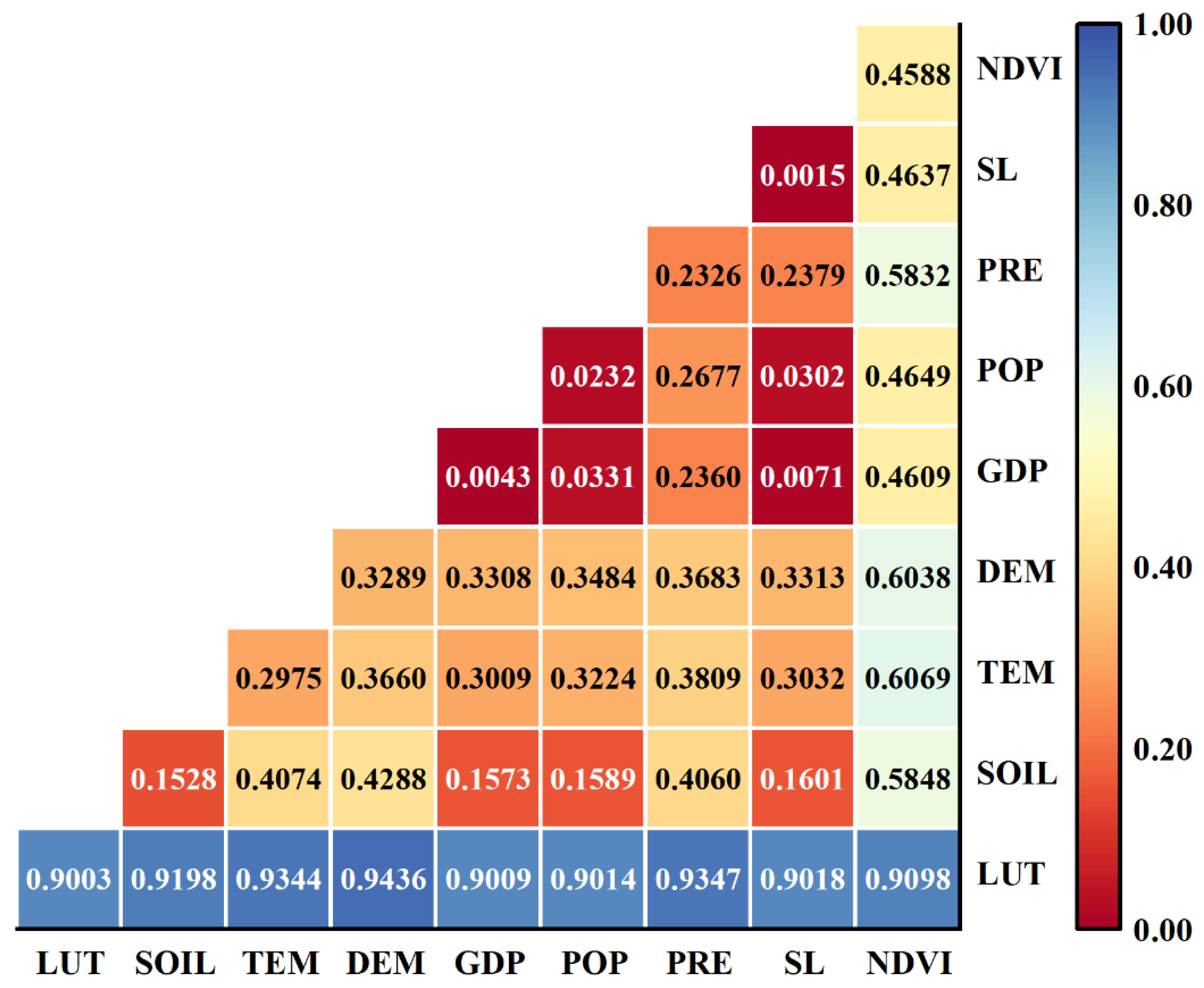
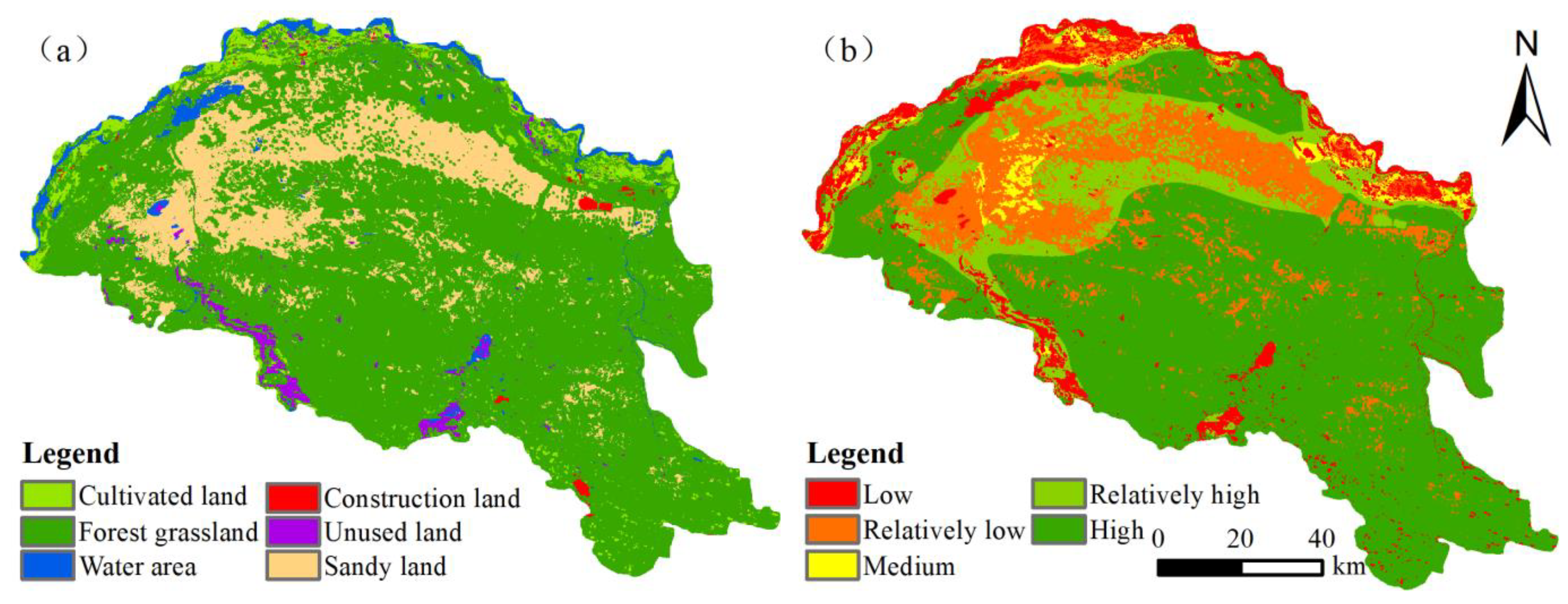
| Index | Expressions | Unit | Applied Scale | Ecological Meaning |
|---|---|---|---|---|
| patch density (PD) | PD = N/A | Pcs/hm2 | landscape | Describes the degree of landscape fragmentation |
| number of patches (NP) | NP = N | Pcs | patch class/landscape | Describes the total number of landscapes |
| landscape shape index (LSI) | None | patch class/landscape | Describes the shape of landscapes | |
| largest patch index (LPI) | % | patch class/landscape | Describes the dominant landscape | |
| splitting index (SPLIT) | None | landscape | Describes the separation level of landscapes | |
| Shannon’s diversity index (SHDI) | None | landscape | Describes the diversity of landscapes | |
| aggregation index (AI) | % | patch class/landscape | Describes the degree of landscape aggregation | |
| contagion index (CONTAG) | % | landscape | Describes landscape connectivity |
| Threat Factors | Maximum Effective Distance (km) | Weight | DECAY |
|---|---|---|---|
| Cultivated land | 4 | 0.6 | linear |
| Construction land | 8 | 0.9 | exponential |
| Unused land | 6 | 0.5 | linear |
| Sandy land | 6 | 0.75 | exponential |
| Land-Use Types | Habitat Suitability | Threat Factors | |||
|---|---|---|---|---|---|
| Cultivated Land | Construction Land | Unused Land | Sandy Land | ||
| Sandy land | 0.1 | 0.1 | 0.3 | 0.3 | 0.1 |
| Forest grassland | 1 | 0.7 | 0.6 | 0.6 | 0.7 |
| Water | 0.9 | 0.6 | 0.2 | 0.4 | 0.3 |
| Unused land | 0.1 | 0.1 | 0.3 | 0.1 | 0.6 |
| Cultivated land | 0.4 | 0.3 | 0.5 | 0.4 | 0.3 |
| Construction land | 0 | 0.1 | 0.3 | 0.2 | 0 |
| Year | Cultivated Land | Forest Grassland | Water Area | Construction Land | Unused Land | Sandy Land | ||||||
|---|---|---|---|---|---|---|---|---|---|---|---|---|
| Area (km2) | % | Area (km2) | % | Area (km2) | % | Area (km2) | % | Area (km2) | % | Area (km2) | % | |
| 1991 | 284.61 | 2.19 | 5254.91 | 40.39 | 583.42 | 4.48 | 8.45 | 0.06 | 162.08 | 1.25 | 6718.67 | 51.63 |
| 2000 | 394.73 | 3.03 | 6260.96 | 48.12 | 467.77 | 3.6 | 11.42 | 0.09 | 139.3 | 1.07 | 5737.09 | 44.09 |
| 2010 | 489.14 | 3.76 | 7267.08 | 55.85 | 376.69 | 2.9 | 27.28 | 0.21 | 44.55 | 0.34 | 4806.61 | 36.94 |
| 2019 | 511.67 | 3.93 | 8827.41 | 67.84 | 322.67 | 2.48 | 50.76 | 0.39 | 158.38 | 1.22 | 3140.46 | 24.14 |
| Land-Use Type | Change in Area (km2) | Land-Use Dynamics | Comprehensive Land-Use Dynamics | |||||||||
|---|---|---|---|---|---|---|---|---|---|---|---|---|
| 1991–2000 | 2000–2010 | 2010–2019 | 1991–2019 | 1991–2000 | 2000–2010 | 2010–2019 | 1991–2019 | 1991–2000 | 2000–2010 | 2010–2019 | 1991–2019 | |
| Cultivated land | 110.12 | 94.41 | 22.53 | 227.06 | 4.3 | 2.39 | 0.46 | 4.93 | 1.22 | 1.08 | 1.69 | 0.68 |
| Forest grassland | 1006.05 | 1006.12 | 1560.33 | 3572.5 | 2.13 | 1.61 | 2.15 | 4.5 | ||||
| Water area | −115.65 | −91.08 | −54.09 | −260.82 | −2.2 | −1.95 | −1.44 | −8.98 | ||||
| Construction land | 2.97 | 15.86 | 23.48 | 42.31 | 3.91 | 13.89 | 8.61 | 9.26 | ||||
| Unused land | −22.78 | −94.75 | 113.83 | −3.7 | −1.57 | −6.8 | 25.55 | −0.26 | ||||
| Sandy land | −981.58 | −930.48 | −1666.15 | −3578.21 | −1.62 | −1.62 | −3.47 | −12.66 | ||||
| Grade | 1991 | 2000 | 2010 | 2019 | ||||
|---|---|---|---|---|---|---|---|---|
| Area | Percentage | Area | Percentage | Area | Percentage | Area | Percentage | |
| Low | 7046.91 | 54.16 | 1420.42 | 10.92 | 912.78 | 7.02 | 996.03 | 7.66 |
| Relatively low | 1287.31 | 9.89 | 5346.16 | 41.09 | 4841.59 | 37.21 | 3220.80 | 24.75 |
| Medium | 1068.57 | 8.21 | 764.41 | 5.87 | 288.84 | 2.22 | 395.16 | 3.04 |
| Relatively high | 1317.91 | 10.13 | 1299.37 | 9.99 | 1229.24 | 9.45 | 1462.02 | 11.24 |
| High | 2290.10 | 17.60 | 4180.95 | 32.13 | 5738.84 | 44.11 | 6937.29 | 53.32 |
| Changes in Habitat Quality | 1991–2000 | 2000–2010 | 2010–2019 | 1991–2019 | ||||
|---|---|---|---|---|---|---|---|---|
| Area | % | Area | % | Area | % | Area | % | |
| Obvious improvement | 1603.54 | 12.32 | 1161.47 | 8.93 | 865.90 | 6.66 | 4255.01 | 32.71 |
| Slight improvement | 8509.13 | 65.40 | 9690.60 | 74.49 | 6194.69 | 47.62 | 6129.32 | 47.12 |
| Invariable | 84.32 | 0.65 | 1182.87 | 9.09 | 3461.92 | 26.61 | 142.22 | 1.09 |
| Slight degeneration | 2043.77 | 15.71 | 892.42 | 6.86 | 2238.56 | 17.21 | 1946.91 | 14.97 |
| Severe degeneration | 770.03 | 5.92 | 81.98 | 0.63 | 248.24 | 1.91 | 535.74 | 4.12 |
| Influence Factors | Land-Use Type (LUT) | Soil Type (SOIL) | Temperature (TEM) | Elevation (DEM) | GDP | Population Density (POP) | Precipitation (PRE) | Slope (SL) | NDVI |
|---|---|---|---|---|---|---|---|---|---|
| q value | 0.9003 | 0.1528 | 0.2975 | 0.3289 | 0.0043 | 0.0232 | 0.2326 | 0.0015 | 0.4588 |
| Land-Use Type | Area (km2) | Change in Area (km2) | Change Rate (%) | |
|---|---|---|---|---|
| 2019 | 2030 | |||
| Cultivated land | 511.67 | 522.35 | 10.68 | 2.09 |
| Forest grassland | 8827.41 | 9719.40 | 891.99 | 10.10 |
| Water area | 322.67 | 355.98 | 33.31 | 10.32 |
| Construction land | 50.76 | 55.72 | 4.96 | 9.77 |
| Unused land | 158.38 | 216.59 | 58.21 | 36.75 |
| Sandy | 3140.46 | 2139.22 | −1001.24 | −31.88 |
| Grade | 2019 | 2030 | 2019–2030 | |||
|---|---|---|---|---|---|---|
| Area | Percentage | Area | Percentage | Area | Percentage | |
| Low | 996.03 | 7.66 | 355.99 | 2.74 | −640.04 | −4.92 |
| Relatively low | 3220.80 | 24.75 | 739.69 | 5.69 | −2481.11 | −19.07 |
| Medium | 395.16 | 3.04 | 2229.41 | 17.14 | 1834.25 | 14.10 |
| Relatively high | 1462.02 | 11.24 | 320.71 | 2.47 | −1141.31 | −8.77 |
| High | 6937.29 | 53.32 | 9363.58 | 71.98 | 2426.29 | 18.66 |
Disclaimer/Publisher’s Note: The statements, opinions and data contained in all publications are solely those of the individual author(s) and contributor(s) and not of MDPI and/or the editor(s). MDPI and/or the editor(s) disclaim responsibility for any injury to people or property resulting from any ideas, methods, instructions or products referred to in the content. |
© 2023 by the authors. Licensee MDPI, Basel, Switzerland. This article is an open access article distributed under the terms and conditions of the Creative Commons Attribution (CC BY) license (https://creativecommons.org/licenses/by/4.0/).
Share and Cite
Meng, R.; Cai, J.; Xin, H.; Meng, Z.; Dang, X.; Han, Y. Spatio-Temporal Changes in Land Use and Habitat Quality of Hobq Desert along the Yellow River Section. Int. J. Environ. Res. Public Health 2023, 20, 3599. https://doi.org/10.3390/ijerph20043599
Meng R, Cai J, Xin H, Meng Z, Dang X, Han Y. Spatio-Temporal Changes in Land Use and Habitat Quality of Hobq Desert along the Yellow River Section. International Journal of Environmental Research and Public Health. 2023; 20(4):3599. https://doi.org/10.3390/ijerph20043599
Chicago/Turabian StyleMeng, Ruibing, Jiale Cai, Hui Xin, Zhongju Meng, Xiaohong Dang, and Yanlong Han. 2023. "Spatio-Temporal Changes in Land Use and Habitat Quality of Hobq Desert along the Yellow River Section" International Journal of Environmental Research and Public Health 20, no. 4: 3599. https://doi.org/10.3390/ijerph20043599
APA StyleMeng, R., Cai, J., Xin, H., Meng, Z., Dang, X., & Han, Y. (2023). Spatio-Temporal Changes in Land Use and Habitat Quality of Hobq Desert along the Yellow River Section. International Journal of Environmental Research and Public Health, 20(4), 3599. https://doi.org/10.3390/ijerph20043599







